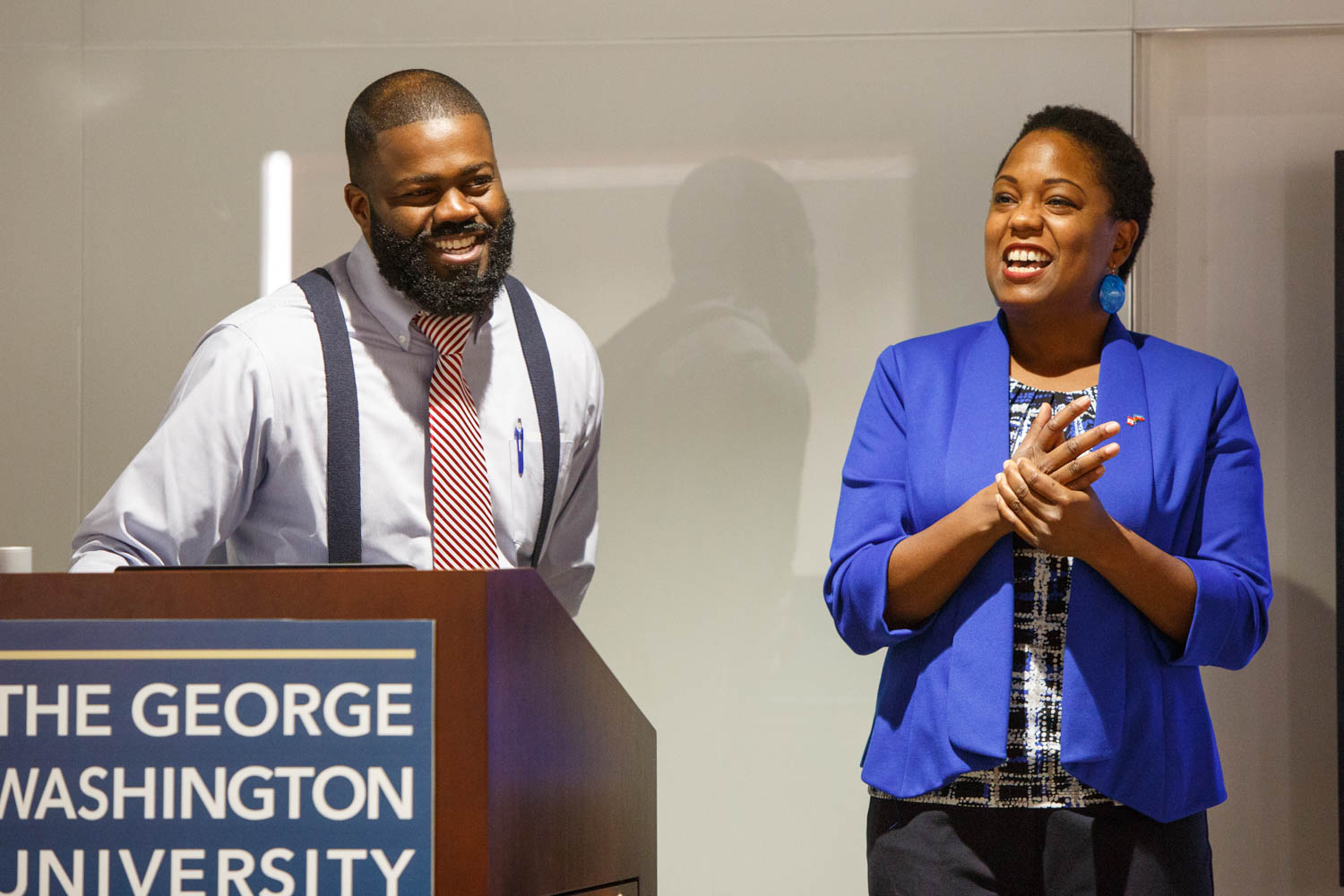By B.L. Wilson
Many people know Haiti as an impoverished land devastated by a massive earthquake that suffered again this year by the 100-mph winds of Hurricane Matthew, a natural disaster that killed as many as 1,000 people.
Rachel Decoste, a second year GW graduate student in public administration, wants people to know about the Haitian people—their pride, resilience and long history of overcoming natural and man-made calamities.
Ms. Decoste organized a teach-in that she said was meant to dispel some myths and challenge the negative narratives about Haiti and invited the George Washington University community to Gelman Library Monday evening for what was billed as “Keep Calm and Discover Haiti.” It was an introduction to the country’s rich history and culture that has deep roots in Latin American history and pops up in unexpected ways in modern popular culture.
Kevin Lombardi, a medical student on a panel of GW students that volunteered in Haiti after the 7.0 earthquake in 2010 said, “What really struck me about Haiti is what is shown and what was there.” The media’s tendency he said is to focus on the buildings and infrastructure. “If I see another picture of dirt in Port-au-Prince or of trash,” he said, “I’m going to die of acid reflux because the country is gorgeous.”
It helps, he said, to get outside the cities to a village like Pont Morel where he visited with a young woman, Marie-Flore St. Fleur, who served as his translator. He later married her. She introduced him not only to her family but also to the spirits that dwell by the wells and in the trees.
“My wife’s people have lived in Pont Morel since they were taken from Africa,” Mr. Lombardi said. “She can name back generations all the way to the last slave owner who owned Morel and his slaves.”
As a first-generation Haitian American, Frantz Derenoncourt Jr. said his parents did not talk to him about Haiti’s history. While he was in school in the 1980s, he remembered, “I would get teased because of my nationality so I tried to hide my identity because it was nothing to be proud of.”
It was not until his late 30s, he said, that he learned of the Haitian Revolution—that led to the first independent black nation in the West—and read everything he could about it.
In his talk, Mr. Derenoncourt recounted how one man, Boukman Dutty, a slave from Jamaica, was shipped to Saint Domingue as the French colony was then known. There he learned of the French Revolution, organized an uprising of thousands of slaves and was executed. Mr. Derenoncourt said Toussaint Louverture took up the fight in 1794 ultimately defeating the French, Spanish and British armies.
Much of this story Mr. Derenoncourt has told in a children’s book, “Haiti, The First Black Republic.”
“I wish I had had this book when I was a kid, but even adults can learn from it,” he said. “People all over the world were talking about Toussaint Louverture. He was up there with Napoleon and George Washington.”
Ms. Decoste explained that Haiti was vital to the French economy. It was the most lucrative colony in the world that relied on a brutal slavery system that was 95 percent black. Though Louverture was also captured, Haiti’s revolution raged on for years ending in 1803 when Jean-Jacques Dessalines declared independence.
In seeking release, Haitians sometimes turned to magic, according to GW student Carl-Gester St. Jean, giving rise to a belief by some in zombies, bodies that were brought back to life after death and transported back to Africa. The phenomenon came to the attention of the Western world in the early 20th century. The fascination has lingered, tapped into by Hollywood in the 1932 movie “White Zombie,” Michael Jackson’s “Thriller” video and the current popular TV show, “The Walking Dead.”
The magic is sometimes confused with but is separate from the religion, Voodoo, a mixture of Catholicism and African religions that has infused Haitian culture from its revolutionary beginnings until today.
Caroline Laguerre-Brown, GW’s vice provost for diversity, equity and community, sat on a panel with other Haitian Americans. She shared experiences of growing up in a tight-knit community where first communion was celebrated as a rite of passage and an opportunity to show off a family’s triumphs and children’s accomplishments.
Ms. Laguerre-Brown and other Haitian Americans spoke of the black Madonna, a Catholic saint who is especially revered by Haitians.
Ms. Decoste noted that pilgrimages to the National Shrine of our Lady of Czestochowa, the black Madonna in Doyleston, Penn., are a tradition in Haitian communities, linked to Polish support of the Haitian revolution.
Rolph Tima, a GW freshman from Florida, explained that his surname is Polish derived perhaps from a relative who was Polish or someone who simply took on the name, a tradition among the descendants of slaves who were often stripped of their legacy.
After the 2010 earthquake, in which more than 300,000 people died, GW sent emergency medical and nursing personnel to Haiti, and GW students raised more than $9,000 for disaster relief and organized a candlelight vigil and letter-writing event. After Hurricane Matthew, George Washington President Steven Knapp asked Doug Shaw, senior vice provost for international strategy, to lead the university’s ongoing relief efforts.


